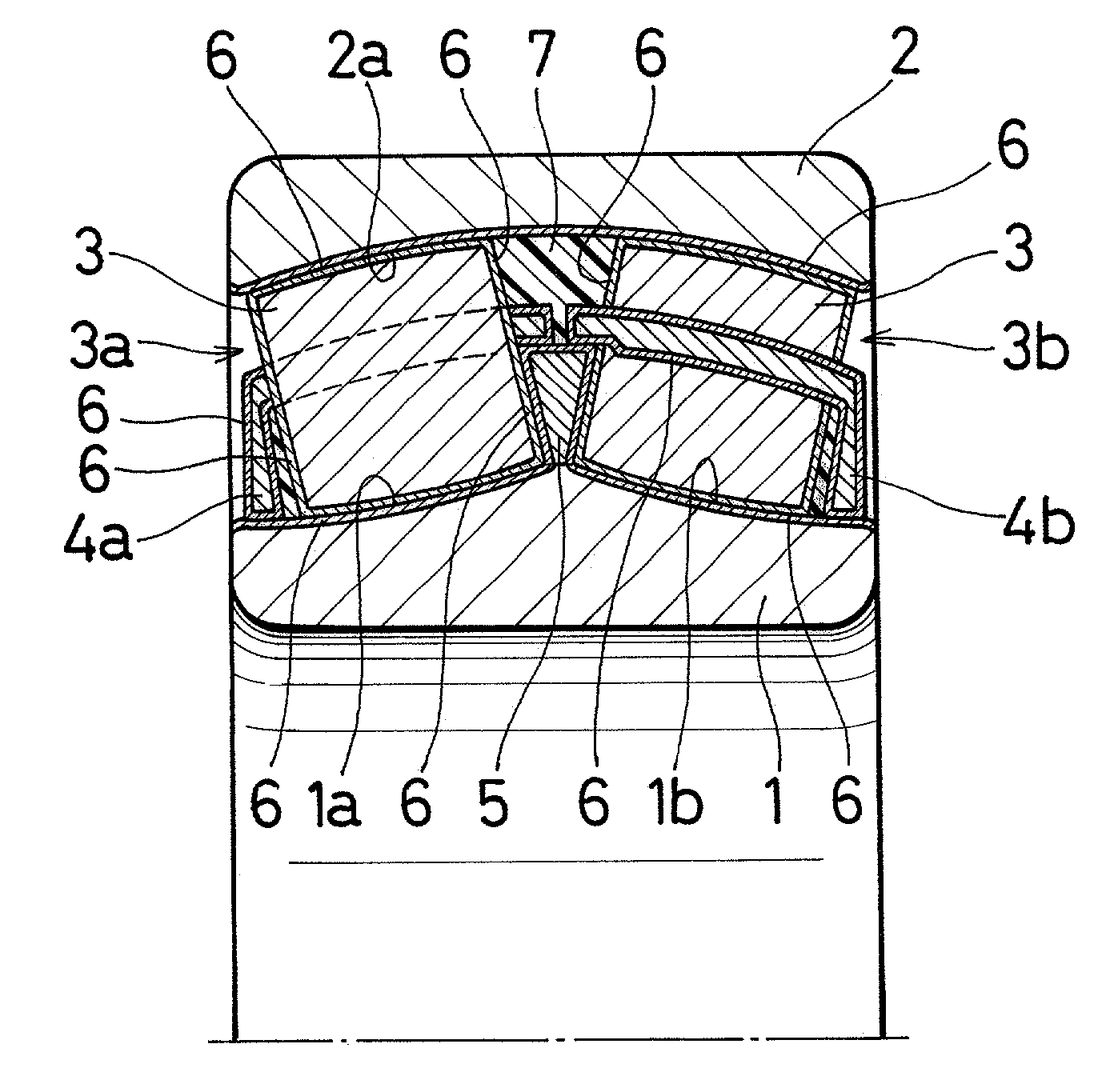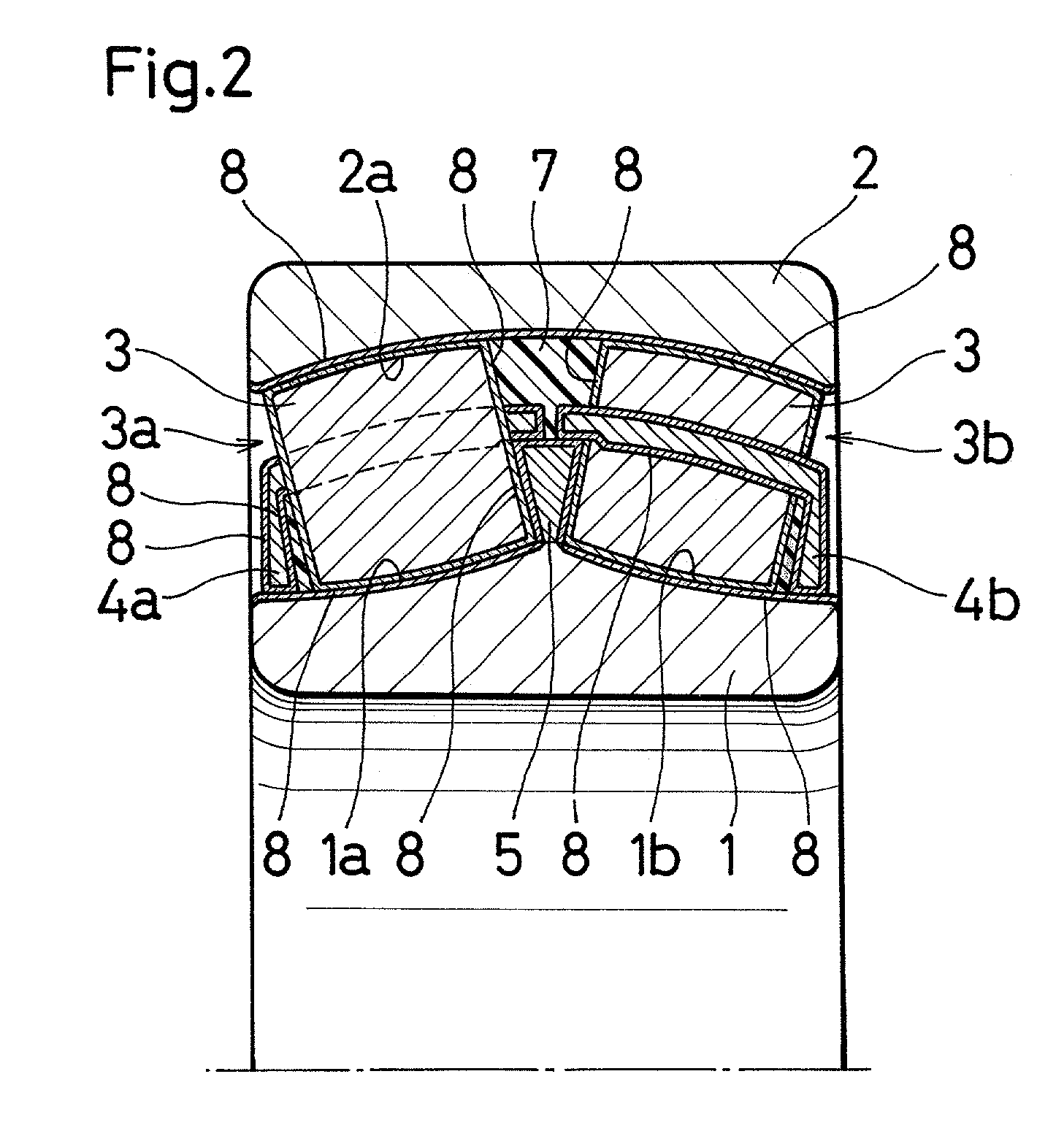[0015]The invention has been conducted in view of these problems. It is an object of the invention to provide a polymeric lubricant packed bearing in which the sliding frictional resistance between a polymeric lubricant, and rolling elements or inner and outer races can be sufficiently reduced, the rotational torque is small, and problems such as melting or damage of the polymeric lubricant due to
self heating can be solved, and also a method of producing such a polymeric lubricant packed bearing.
[0016]It is another object of the invention to provide a method which can produce easily and stably a polymeric lubricant packed bearing having a structure in which a polymeric lubricant packed between inner and outer races of a double-row self-aligning roller bearing is divided in a gap between two rolling element rows so as to be independently rotatable.
[0025]Namely, a film composed of grease or a thickener for grease is formed on a portion of the surface of each of components constituting the bearing, the portion being opposed to the polymeric lubricant. According to the configuration, as compared with the case where a film of lubricating oil is formed on such portions, the sliding frictional resistance of the polymeric lubricant during rotation of the bearing can be surely reduced by virtue of the firmness of the film, so that effects of reducing the rotational torque of the bearing, and of suppressing
self heating can be attained.
[0027]In the case where a film of grease is to be formed, when the grease contains a
base oil not having compatibility with a
base oil of the polymeric lubricant as previously described, the
base oil in the grease can be prevented during a process of heating and shaping of the polymeric lubricant inside the bearing, from being mutually dissolved in the polymeric lubricant to be incorporated thereinto. Therefore, the above-mentioned effects can be attained more surely.
[0029]A further aspect of the invention is a method in which the film composed of grease or that composed of a thickener for grease is formed efficiently and surely in the bearing at a required thickness. When bearing components on which the film is to be formed, or the assembled bearing is immersed into a liquid which is obtained by diluting the grease or the thickener for grease with a
solvent, and the solvent is then dried, a substantially uniform film composed of the grease or the thickener for grease can be easily formed on the surface of the components of the bearing, and the film thickness can be controlled by the
dilution ratio of the grease or the thickener for grease to the solvent. The method in which the assembled bearing is immersed into the liquid can be conducted simply by immersing a bearing which is assembled by a standard assembling method, in a liquid, and then
drying. Therefore, the method does not require a special production facility and complex production steps, and hence is preferably used.
[0033]In a double-row self-aligning roller bearing, as shown in FIG. 3, an outer race having a raceway surface which is arcuate in an axial section can be freely swung about an axis perpendicular to the bearing center axis, with respect to an
assembly configured by an inner race, two rolling element rows, and two cages respectively holding the rolling element rows. When annular members which are removable in a state where center axes of the inner and outer races are made incoincident with each other, such as division annular members which are formed by
cutting a ring into plural portions are used as the division spacers, therefore, the division spacers can be easily inserted at a position where the space between the inner and outer races is divided in two, i.e., between the rolling element rows in a state where the outer race is shifted so as to make the rotation center axis of the outer race and that of the inner race incoincident with each other as shown in FIG. 3. In the state where the division spacers are inserted, the outer race is returned to its original
normal position, or to a state where the rotation center axes of the outer and inner races are made coincident with each other, and the raw materials of the polymeric lubricant are poured between the inner race and the outer race to be solidified. The outer race is again shifted as shown in FIG. 3, so that the division spacers can be removed away. After the removal of the division spacers, the polymeric lubricant between the outer and inner races is in the state where it is axially divided in two at an axial center portion, with the result that a polymeric lubricant packed bearing having independent polymeric lubricants that are disposed respectively for rolling element rows can be obtained.
 Login to View More
Login to View More  Login to View More
Login to View More 


